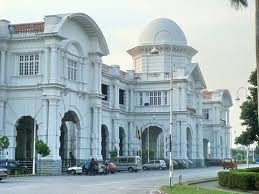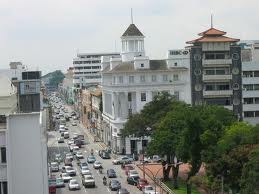

Sri Kedawang official website for tourism and travel information
TRAVEL & TOURS (W) SDN BHD

Copyright @ 2010 Sri Kedawang Travel & Tours












Ipoh is the state capital of Perak, on the west coast of peninsular Malaysia.
Ipoh developed into one of Malaysia's main cities due to the booming tin mining industry around the turn of the 19th century. During the British colonial era, Ipoh was Malaysia's second city for administration purposes. There are several notable buildings from the British Colonial era such as the railway station and the town hall. The population of Ipoh is about 70% of Chinese origin
These days Ipoh is perhaps best known for its excellent restaurants, hawkers, and famous local dishes.
Get in
The most practical means of reaching Ipoh is bus, although train services have sped up and increased considerably since the line from Kuala Lumpur was double-tracked.
By plane
Ipoh is served by the Sultan Azlan Shah Airport . Firefly operates daily flights to and from the budget terminal of Singapore Changi Airport.
By train
There are the regular KTM trains, Ipoh - KL is RM12 economy, RM22 2nd class. The electric train service (ETS) costs RM30 one way (promotion price until Feb 2011). Although the train is fast, the journey takes takes 2 to 3 hours as it stops at several stations. The first train departs KL Sentral at 6:20am and the last train at 9pm.
Ipoh is on the Singapore-Kuala Lumpur-Penang-Bangkok route so there are also trains to and from Penang (Butterworth) and all the way to Bangkok.
By bus
The main Ipoh bus terminal is located at Medan Gopeng. The station provides services to and from just about any location in the country. Most frequent routes are to and from Kuala Lumpur (Puduraya Station) and Penang. Larger bus companies like Transnational, Plusliner, Konsortium provide the most frequent, reliable and safe services.
Bus companies also operate out of other locations including Jalan Bendahara for services to and from Singapore and Jalan Bercham for the Starshuttle [2] and YoYo [3] bus service to and from the Kuala Lumpur International Airport.
By car
Ipoh is well connected to the North-South Expressway. You can get into Ipoh via Exit 137: Simpang Pulai or Exit 139: Ipoh Selatan
Get around
By car
The city centre has mostly one-way streets, which are built in a grid pattern. City road maps are easily available at bookstore, tourist centres and even online. It is advisable to have a map handy. Ipoh's traffic is not as congested as other cities such as Kuala Lumpur. However, like any major cities, traffic slowdown is inevitable especially during heavy traffic such as the morning drive to work (around 8AM-9AM), (noon-1.30PM) during weekdays due to lunch-hour & school children being in/out of school and late evening return from work (around 5PM-6PM). Parking spaces are adequate although finding one may require some patience. Car rentals are available.
By bus
Public buses do ply certain routes but information about the routes are not published and buses are rarely on time. Consulting locals would be the best way to find out information about getting around on public buses.
On foot
Ipoh is a rather pedestrian-unfriendly city, but certainly better than KL. Walking within Ipoh city centre and Ipoh Old Town is feasible but walking long distance generally is not. New town and the outlying suburbs are not good at all for pedestrians.
By bicycle
There are no hard and fast rules for cyclists, but you are expected to observe road rules at all times. Cyclists are forbidden from riding on the sidewalk but often do. Helmets are optional but not common.
Kek Lok Tong
Within Ipoh
Ipoh Old Town has much character and contains many marks of its colonial past including:
•Padang Ipoh or Ipoh Field is located on Jalan S.P. Seenivasagam. The field is a well kept and surrounded by many historic buildings that feature classic colonial architecture, including the mock-tudor style Ipoh Club, FMS Bar, HSBC Building and the magnificant St Michael's Institution secondary school.
•The Ipoh Railway Station. It bears similar architecture to that of the Old Kuala Lumpur Railway Station and is nicknamed the "Taj Mahal of Ipoh"
•Ipoh Town Hall located across the road from the Railway Station also features some interesting gothic architecture.
•Muzium Darul Ridzuan is an interesting historical museum of Perak, located in a pretty former tin-mining tycoon's mansion on Jalan Kuala Kangsar
•Mariamman kovil is an ancient Tamilian temple more than 50 years old .Not only it is a religieous in nature but also a place for discourses and on sundays children are given an introduction to verses in tamil.Located in Jalan Sungai pari buntong, just before the bridge on river.
Around Ipoh
•Kellie's Castle, the deserted mansion of an eccentric Scottish planter, is in Batu Gajah, half an hour's drive from Ipoh city center. Its main appeal lies in the belief that it is haunted and that secret passages leading to hidden chambers exist. A taxi will cost you around RM 50 - 60 and they will usually wait for an hour (which is long enough to look around). There is an entrance fee to the castle.
•Perak Tong (Perak Cave) is located at Gunung Tasek and houses over 40 Buddha statues and many murals. There is a steep, tall staircase in the interior of the cave rising up to the top of its hill, where one is greeted by a beautiful and panoramic view of Ipoh and its surroundings. The statue of Buddha in Perak Tong is the tallest and largest of its kind in Malaysia. Perak Tong was built in 1926 by a Buddhist priest from China.
•Sam Poh Tong (Cavern of Triple Gems) is a Chinese temple located at Gunung Rapat near the Simpang Pulai Toll exit(less than 10 minutes drive from the toll). The temple is built within a limestone cave. It has a popular attraction: a tortoise pond which houses hundreds of tortoises and terrapins (a symbol of longevity) of various sizes. There are several other cave temples immediately next to Sam Poh Tong, for example Nan Tian Tong. They have been renovated recently and now stands colourful buddha statues and chinese zodiac animals for children and adults to ride on and take pictures. Right outside Sam Poh Tong is the infamous Pamelo stalls next to the main road.
•Kek Lok Tong (or Kek Look Tong, Cavern of Ultimate Bliss) [4], a cave temple that lies on the other side of the same limestone hill as Sam Poh Tong, is accessible only through Gunung Rapat housing area. Hence, Kek Lok Tong has a cleaner, quieter and more cooling environment and has the best scenic view from the cave.



